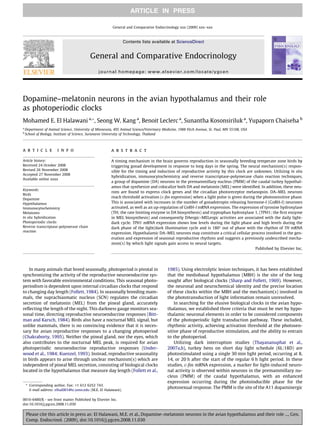
gce09 1
- 1. Dopamine–melatonin neurons in the avian hypothalamus and their role as photoperiodic clocks Mohamed E. El Halawani a,*, Seong W. Kang a , Benoit Leclerc a , Sunantha Kosonsiriluk a , Yupaporn Chaiseha b a Department of Animal Science, University of Minnesota, 495 Animal Science/Veterinary Medicine, 1988 Fitch Avenue, St. Paul, MN 55108, USA b School of Biology, Institute of Science, Suranaree University of Technology, Thailand a r t i c l e i n f o Article history: Received 24 October 2008 Revised 26 November 2008 Accepted 27 November 2008 Available online xxxx Keywords: Birds Dopamine Hypothalamus Immunocytochemistry Melatonin In situ hybridization Photoperiodic clocks Reverse transcriptase-polymerase chain reaction a b s t r a c t A timing mechanism in the brain governs reproduction in seasonally breeding temperate zone birds by triggering gonad development in response to long days in the spring. The neural mechanism(s) respon- sible for the timing and induction of reproductive activity by this clock are unknown. Utilizing in situ hybridization, immunocytochemistry and reverse transcriptase-polymerase chain reaction techniques, a group of dopamine (DA) neurons in the premammillary nucleus (PMM) of the caudal turkey hypothal- amus that synthesize and colocalize both DA and melatonin (MEL) were identified. In addition, these neu- rons are found to express clock genes and the circadian photoreceptor melanopsin. DA–MEL neurons reach threshold activation (c-fos expression) when a light pulse is given during the photosensitive phase. This is associated with increases in the number of gonadotropin releasing hormone-I (GnRH-I) neurones activated, as well as an up-regulation of GnRH-I mRNA expression. The expression of tyrosine hydroxylase (TH; the rate limiting enzyme in DA biosynthesis) and tryptophan hydroxylase 1, (TPH1; the first enzyme in MEL biosynthesis) and consequently DAergic–MELergic activities are associated with the daily light- dark cycle. TPH1 mRNA expression shows low levels during the light phase and high levels during the dark phase of the light/dark illumination cycle and is 180° out of phase with the rhythm of TH mRNA expression. Hypothalamic DA–MEL neurons may constitute a critical cellular process involved in the gen- eration and expression of seasonal reproductive rhythms and suggests a previously undescribed mecha- nism(s) by which light signals gain access to neural targets. Published by Elsevier Inc. In many animals that breed seasonally, photoperiod is pivotal in synchronizing the activity of the reproductive neuroendocrine sys- tem with favorable environmental conditions. This seasonal photo- periodism is dependent upon internal circadian clocks that respond to changing day length (Follett, 1984). In seasonally breeding mam- mals, the suprachiasmatic nucleus (SCN) regulates the circadian secretion of melatonin (MEL) from the pineal gland, accurately reflecting the length of the night. This darkness gauge monitors sea- sonal time, directing reproductive neuroendocrine responses (Bitt- man and Karsch, 1984). Birds also have a nocturnal MEL signal, but unlike mammals, there is no convincing evidence that it is neces- sary for avian reproductive responses to a changing photoperiod (Chakraborty, 1995). Neither the pineal gland, nor the eyes, which also contributes to the nocturnal MEL peak, is required for avian photoperiodic neuroendocrine reproductive responses (Under- wood et al., 1984; Kuenzel, 1993). Instead, reproductive seasonality in birds appears to arise through unclear mechanism(s) which are independent of pineal MEL secretion, consisting of biological clocks located in the hypothalamus that measure day length (Follett et al., 1985). Using electrolytic lesion techniques, it has been established that the mediobasal hypothalamus (MBH) is the site of the long sought after biological clocks (Sharp and Follett, 1969). However, the neuronal and neurochemical identity and the precise location of these clocks within the MBH and the mechanism(s) involved in the phototransduction of light information remain unresolved. In searching for the elusive biological clocks in the avian hypo- thalamus, we established three criteria that must be met by hypo- thalamic neuronal elements in order to be considered components of the photoperiodic light transduction pathway. These included, rhythmic activity, achieving activation threshold at the photosen- sitive phase of reproductive stimulation, and the ability to entrain to the photoperiod. Utilizing dark interruption studies (Thayananuphat et al., 2007a,b), turkey hens on short day light schedule (6L:18D) are photostimulated using a single 30 min light period, occurring at 8, 14, or 20 h after the start of the regular 6 h light period. In these studies, c-fos mRNA expression, a marker for light-induced neuro- nal activity is observed within neurons in the premammillary nu- cleus (PMM) of the caudal hypothalamus, with an enhanced expression occurring during the photoinducible phase for the photosexual response. The PMM is the site of the A11 dopaminergic 0016-6480/$ - see front matter Published by Elsevier Inc. doi:10.1016/j.ygcen.2008.11.030 * Corresponding author. Fax: +1 612 6252 743. E-mail address: elhal001@tc.umn.edu (M.E. El Halawani). General and Comparative Endocrinology xxx (2009) xxx–xxx Contents lists available at ScienceDirect General and Comparative Endocrinology journal homepage: www.elsevier.com/locate/ygcen ARTICLE IN PRESS Please cite this article in press as: El Halawani, M.E. et al., Dopamine–melatonin neurons in the avian hypothalamus and their role ..., Gen. Comp. Endocrinol. (2009), doi:10.1016/j.ygcen.2008.11.030
